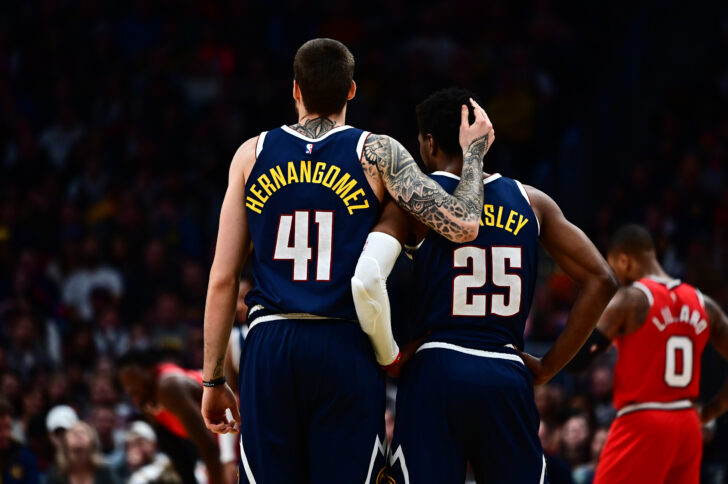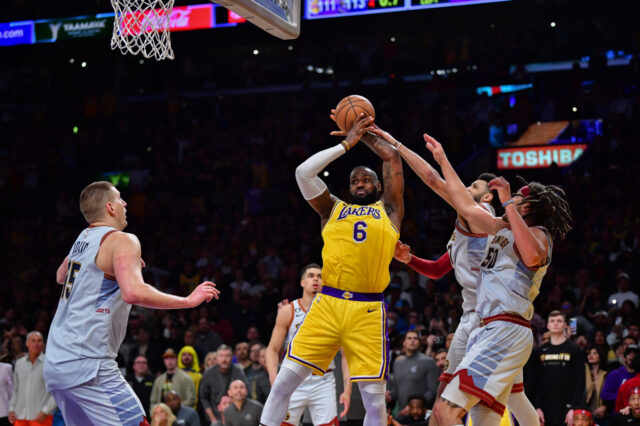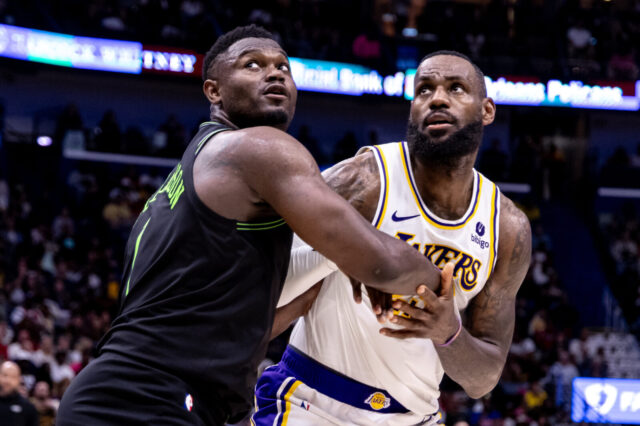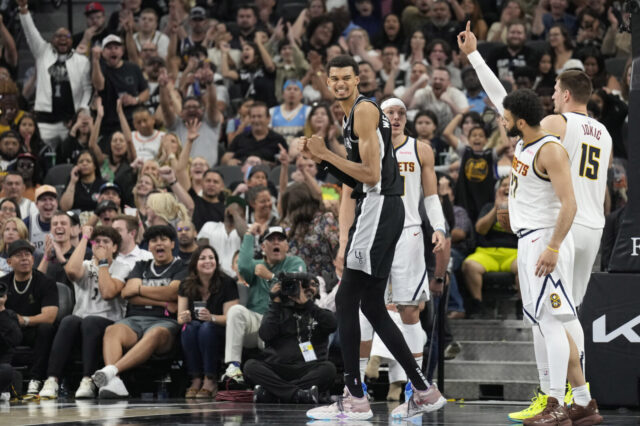The Denver Nuggets defeated the Portland Trail Blazers in emphatic fashion on Tuesday night, but Denver’s eighth-straight win against a division opponent was massively overshadowed when Shams Charania of The Athletic reported that the Nuggets were the fourth and final team involved in a 12-player trade which shook up the enitre National Basketball Association.
In the trade, there were four teams who sent some mixture of players and picks: the Houston Rockets, Atlanta Hawks, Minnesota Timberwolves, and the Nuggets.
The Rockets sent both Clint Capela and Nene to the Atlanta Hawks as well as sending Gerald Green to the Nuggets. They received Robert Covington and Jordan Bell from Minnesota.
The Timberwolves sent out Covington and Bell to the Rockets. They also sent Shabazz Napier, Keita Bates-Diop and Noah Vonleh to the Nuggets. In return, they received Malik Beasley, Juancho Hernangomez and Jarred Vanderbilt from Denver; Evan Turner from the Hawks; and the Atlanta Hawks first round pick which was originally owned by the Brooklyn Nets.
For the Hawks, they chose to send out Turner and the first round pick they acquired from Brooklyn to Minnesota. For their work, they received Capela and Nene.
The Nuggets sent out Beasley and Hernangomez, who were both drafted together in 2016, and Vanderbilt, who was Denver’s second round pick in 2018. In return, they received Vonleh who can play center or power forward, Napier who becomes Denver’s third point guard, and Bates-Diop who is a young forward the Nuggets could utilize down the road. Additionally, the Nuggets received Houston’s first-round pick for this coming draft.
The Nuggets also technically acquired Gerald Green from Houston, who is currently out with a broken foot, but a league source has told Mile High Sports that Green will be waived.
By the time the trade was agreed upon, it was the biggest deal since the 2000 season when the Knicks moved Patrick Ewing to Seattle according to Bobby Marks of ESPN.
For the Nuggets, this trade accomplishes a few different things.
First off, it seemed like Beasley and Hernangomez — both of whom are heading to Minnesota in the trade — were on their way out of Denver anyway. They were both set to be restricted free agents after this season and, with Denver’s financial situation being difficult to manage going forward, they were likely to end up as cap casualties. So instead of losing both without getting anything in return, Nuggets president of basketball operations Tim Connelly traded both.
In addition to the financial motivations to trade Beasley and Hernangomez, Michael Porter Jr.’s emergence eliminated the need for each of them so long as the roster is healthy. The only way each of Beasley and Hernangomez were going to play consistent minutes is if the Nuggets were dealing with a plethora of injuries, like they are currently trying to manage.
Despite their injury issues, Denver found a way to turn both Beasley and Hernangomez into not only a first-round pick, but they also acquired two solid reserves in Vonleh and Napier in addition to a young forward in Bates-Diop who can grow with the roster. On the surface, it isn’t a massive difference-maker for the Nuggets, but it is still an overall good deal to get value for players who could have walked for free at the conclusion of the season.
But when you start to look closer at what the Nuggets accomplished with their trade, there are some interesting clues as to what the Nuggets could look to do next.
The Clint Capela effect
One of the underlying reasons for the Nuggets inclusion in this insane four-team trade is that it helped facilitate the deal that sent Capela to the Eastern Conference.
When the Nuggets battle with the Rockets, Capela has been one of the biggest advantages Houston had. Nikola Jokic struggles with hyper-athletic centers; particularly lob threats. When James Harden would run a pick and roll against Denver with Capela setting the screen, it almost always led to points for Houston. If Denver played at the level of the screen, Capela would slip and be wide open for a dunk. If Denver dropped, Jokic was stuck trying to contain Harden while back pedaling. If the weak-side defense slides over to stop Capela from slipping the screen to the rim, the three-point shooter in the corner was wide open. There was absolutely no good choice for Denver in that situation. Now that Capela is gone and P.J. Tucker seems to be their starting center going forward, the Nuggets suddenly have a significantly better chance of limiting the Rockets offense.
In addition to being able to defend the Rockets better, the trade also opened things up on offense for the Nuggets if matched up with Houston. While Tucker is an underrated defender and Covington can guard four positions, the Rockets suddenly have absolutely no one who can defend Jokic one-on-one in the post. That alone means that the Nuggets should be favored in any meeting with the Rockets going forward being that Jokic could score at will or pass to open teammates if doubled.
Being able to make the Rockets much less menacing in the playoffs is not a small victory for the Nuggets. If Denver ends up matched up with them in the postseason and win, remember this trade as a big reason why.
More flexibility to make additional trades
At first glance, the additions of Vonleh and Napier seem strange on this Nuggets roster.
Denver has a very good backup point guard in Monte Morris who is already better than Napier. Mason Plumlee is one of Malone’s most trusted players and is a better reserve center than Vonleh is. So what gives?
Well, it seems like the Nuggets are not yet done wheeling and dealing.
First off, once this trade is completed, none of the players involved will be able to be traded before the deadline, but the draft picks that were moved are able to be aggregated into deals. What this means is that Denver cannot trade Bates-Diop, Vonleh or Napier before the trade deadline ends so all three will be on the roster for at least the rest of this season, but if Denver wanted to trade the first round pick the received from Houston, they are able to do so.
So why did Denver make this deal and acquire players who are redundant on their roster? Well, if Denver ended up trading Plumlee or Morris, they would need replacements. That is why so many people are speculating that this trade is just a precursor to another deal that Denver is set to make.
That leads everyone to asking the same question. So just what trade could Denver be interested in?
Well, the most exciting answer to that question is none other than Jrue Holiday of the New Orleans Pelicans, who is one of the most sought-after players leading up to the trade deadline. To make things even more exciting, it seems that the clues that remain after Denver’s deal on Tuesday night all tend to lead to the idea that Denver will try to pry Holiday away from the Pelicans.
If Denver wanted to trade for Holiday, the most likely trade scenario looks like this:
In addition to the players involved, Denver would be sending the first round pick they acquired from Houston on Tuesday night as well as whatever draft compensation that the Pelicans asked for which, in this case, would likely be Denver’s 2022 first round pick. Denver could also choose not to ask for E’Twuan Moore being that the financial aspect of the trade works with or without him.
While this trade scenario is purely speculation, the greater point stands: the Nuggets now have a first round draft pick to dangle in trade talks and enough depth to utilize their assets to make an even bigger splash. They could look into trading for Holiday like I outlined above or use the same exact ideas and apply them to a potential pursuit of Bradley Beal this offseason.
Again, this is all speculation, but the Nuggets are now more equipped to make a big trade than they were 24 hours ago.
What comes next
Now, according to Adrian Wojnarowski of ESPN, the Nuggets will continue using their newly acquired first round pick to find other deals which could improve their roster.
This Nuggets trade, while not bad on its own, seems to be a starting point for bigger deal. The Nuggets know that they have a realistic shot at making the finals this year so it seems they are willing to push a good amount of their chips into the center of the table to make that happen.
Even if the Nuggets do not find an additional deal before the trade deadline, their roster was destined for upheaval as it is. The Nuggets will have up to seven players entering restricted or unrestricted free agency after this year so change is inevitable.
Now, the Nuggets have the depth to make another trade while not sacrificing their future financial flexibility. Both Napier and Vonleh will be unrestricted free agents at the end of the year while Bates-Diop’s contract is not guaranteed. If Denver wanted to cut ties with all parties involved, they have the ability to do so. They did not take in any long-term money with this trade.
Denver essentially got ahead of their unavoidable roster shakeup and managed to acquire more flexibility and a first round pick in the process. Overall, Denver’s deal could have been much worse and has the potential to end up as one of the defining moments of Connelly’s career if it ends up being just the first step to acquiring another near-star to add to Denver’s roster.
Only time will tell. The NBA trade deadline is on Thursday afternoon at 3pm EST.




